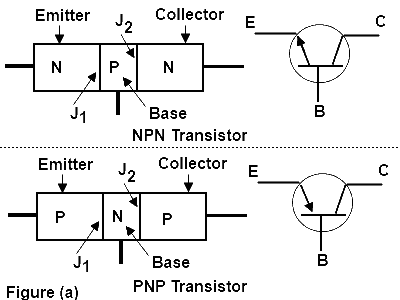

One LED should be ON while the switch is pressed, then should switch to the other if pressed.Įdit 2: Thank you for all your amazing additions to the post. A PNP transistor gets positive voltage at the emitter terminal. Some basic Idea, without any resistors (since they are part of my problem: I con't find out, where to place them and how strong.) Placed on my breadboard to get started with LEDs. An NPN transistor needs positive current flow from the base to emitter. Thanks für input on this very confusing matter. PNP switches ON by a low signal whereas NPN switches ON by a high signal.
#Pnp transistor vs npn transistor how to#
I am too embarrassed to show any of these noob tries, and just want to ask you guys for Ideas how to approach that problem.Īm I going a completely wrong way with this? PNP- Positive Negative and Positive When electrons enter the base, it turns on. The primary function of a BJT is to amplify current, which allows BJTs to be used as amplifiers. Difference between NPN And PNP Transistors NPN- Negative Positive and Negative. The three terminals of the BJT are the base, the collector, and the emitter. Below is an NPN transistor characteristics for Vbe versus Ic at different Vcb or Vce: It seems like in the active region, Vbe vs Ic curves gets steeper with an increasing Vce. But i do not seem to be able to have either the NPN or PNP transistor not be triggered to a degree somehow. Bipolar Junction Transistors come in two different flavors: NPN and PNP. A Bipolar Junction Transistor (BJT or BJT Transistor) is a three-terminal semiconductor device composed of two P-N junctions that can amplify or magnify a signal. So far, I have tried a lot to get it work somehow. If the GPIO pin goes HIGH or LOW, switch trough either transistor.

I thought about using an NPN and PNP transistor, tying up the base and collector/emitter to 5v power supply. If you like this post probably you might like my next projects, so please support me by subscribing my blog and like my Facebook Page.I want to toggle between 2 devices using one GPIO 3.3v pin and powering them with 5v. Thanks for reading, you can contact me by leaving a comment. In an NPN transistor, the arrow symbol points outward, whereas, in a PNP transistor, the arrow symbol points inward. In this lesson, we will learn about the physics behind transistors and why they are important as semiconductor devices. The main difference is the path of the arrow over the emitter terminal.


 0 kommentar(er)
0 kommentar(er)
